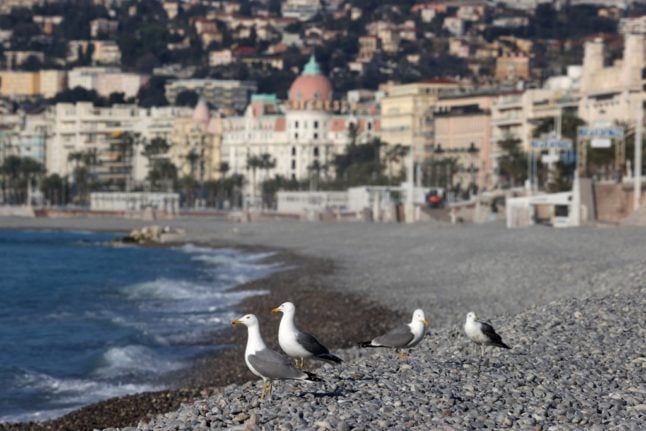1. Villa Les Palmiers
When Nice voted to join France in 1860, the celebration was held at this sprawling estate with Napoleon III in attendance.
Later, an English art dealer bought the property and redecorated with tons of imported marble christening it the Palais de Marbre. Now housing the Municipal Archives, the villa’s splendor is vividly apparent on the southern side where a vast manicured garden made up of reflecting pools and statuary recall the villa’s heyday. On the neo-classical facade is a loggia engraved with John Keats’ reminder that “A thing of beauty is a joy forever”.
Stroll the shady path to the right of the garden and marvel at the ornate dovecote which served as a status symbol and also a source of fresh squab.
7/9 avenue de Fabron
2. Musée International d’Art Naïf
Nearby is this fun museum devoted to naïve art. Paintings, sculptures, drawings and posters trace the evolution of this popular and accessible art form through the works of its most famous painters: Henri Rousseau, Grandma Moses, Ivan and Josip Generalic and many others.
The museum is lodged in the former Chateau Sainte Hélène which once belonged to perfumer François Coty. Linger in the estate’s park marked by the colorful sculptures of Frederic Lanovsky.
23 avenue de Fabron
READ ALSO 10 things you didn’t know about Nice
3. The Castle Hill Cemeteries
The two cemeteries on the northern slope of Castle Hill – Christian and Jewish – are a testament to the remarkable cultural, historical and artistic diversity of Nice.
The 2,250 tombs in the Christian cemetery display an exuberant mixture of artistic styles from sober to bizarre. Wander through the busts, medallions, sad statues, crosses, angels and crying maidens to the Gastaud family tomb where the angel of death hovers over a tomb half-opened by stone hands. It’s hard to miss the 12-metre high Grosso tomb which displays his wife and two children topped by a benevolent angel.
The adjacent Jewish cemetery commemorates the Jews from Nice who perished in the Holocaust as well as local Resistance heroes.
Notice the unusual Asseo tomb adorned with train, plane, car and pine tree sculptures. It is the tomb of a seven-year old boy who asked his parents for his favourite items. Unable to comply with his dying request at the time, they honoured his wishes in death with this moving testament to parental love.
4. Saint Pons Abbey Church
The Saint Pons Abbey is one of the oldest abbeys in the south of France, built in the eighth century on the spot where Saint Pontius of Cimiez was martyred.
Although the abbey is now a part of Pasteur Hospital and is not open for visits, the adjacent church is proudly open to display the results of its recent restoration.
Dating from 1725, the church is a shining example of Nice’s baroque architecture. Highlights of the brightly painted interior include lateral chapels decorated with twisted columns, a painting behind the altar depicting the martyrdom of Saint Pontius, and an exquisite crypt that contains the relics of the martyred saint.
5. Gloria Mansions
Only steps from the well-known Musée des Beaux Arts, lies this Art Deco masterpiece, named a historic monument in 1989. From a distance the grayish facade looks like any other apartment building.
A closer look reveals that the tinted concrete glistens with encrusted oyster shells and the balconies curve like waves in the sea. On the top floor sculpted raptors, inspired by the Chrysler building in New York, guard the building.
Behind the magnificent entrance gate (usually open) lies a courtyard with more stylish stuccoes and bas-reliefs. Peek through the building’s entrance to admire a mammoth glass-mosaic on the opposite side.
Just visible is a monumental concrete staircase supported by green-tinted columns that spiral up to a glass roof. From the bronze hand-crafted letter boxes to the intricate railings and marble floors, Gloria Mansions is the height of 1930s design.
123 rue de France
6. Chateau Valrose
Lucky are the students at the University of Nice who study at this castle-park turned campus. Built in 1870 for a Russian baron and financier, the castle exterior is a festival of spires, pointed arches and massive staircases while the inside boasts crystal chandeliers, frescoes and a 400-seat concert hall.
The park spreads over 10 hectares on Cimiez hill with a Gothic entrance gate on the eastern side to welcome Cimiez’s aristocratic 19th-century visitors. Until the Baron’s death in 1881, the finest musicians of the day performed at the Chateau.
Although the chateau and park are usually closed to random visitors, the University of Nice hosts a regular cycle of concerts and workshops that are open to the public.
28 Avenue Valrose
7. Villa Paradiso
The stately Villa Paradiso and its vast gardens were built in 1881 when everyone with a title or a sizable bank account (preferably both) wanted to stay on the trendy boulevard de Cimiez.
Later it became the residence of Baron Etienne Van Zuylen and his wife Helene, née de Rothschild, who created the Nice chapter of the Society for the Protection of Animals.
After WWII the city of Nice acquired the estate, turning it first into the Conservatory of Music and then trying to sell it. An outcry ensued, the Mayor relented and soon this historic property will house a cancer institute.
24 boulevard de Cimiez
8. Hotel Alhambra
Horseshoe arches and minarets seem out of place in Cimiez but Orientalism was all the rage at the turn of the 20th century. Built in 1900, the building is also unusual as the product of a female entrepreneur, Madame Emilie Gabrielle Sabatier.
This clever lady built her hotel in a neo-Moorish style as a way to attract an international clientele. Business boomed until the outbreak of WWI when it was requisitioned as a military hospital. Guests never returned in force and in 1947 it became an apartment building.
48 boulevard de Cimiez
9. Maison de la Treille
This captivating old house with a luxuriant vine cascading down the front may be the Old Town’s most Instagramable spot.
Treille means “vine” and this one has been here at least since the turn of the 20th century. At one time the buidling was a tavern and then it became a centre for Nice’s language and traditions. Around 1930 artist Raoul Dufy depicted the house in a painting, Le Mai à Nice which now hangs in the Musée des Beaux Arts.
9 rue Saint Augustin
10. Archaeological Crypt
A visit to the archaeological “crypt” is a fascinating peek into medieval Nice. Before Nice’s walls were destroyed in 1706, the Old Town was protected by a system of gates, towers and bastions, none of which are visible today – at least not above ground.
When work began on Nice’s tramway in 2007, workers were startled to discover the intact remains of fortified Nice including a moat and an aqueduct. The crypt stretches over 2,000 square metres under Place Garibaldi with a system of walkways to facilitate visits. Visits must be reserved in advance and include a guided tour (in French).
Place Jacques Toja

Jeanne is a veteran travel writer who has resided in Nice for 22 years. She’s the author of Nice Uncovered: Walks Through the Secret Heart of a Historic City and runs the travel-planning website frenchrivieratraveller.com. Her passion is exploring the many facets of Nice’s fascinating history and culture.



 Please whitelist us to continue reading.
Please whitelist us to continue reading.
Member comments